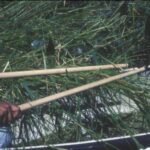Harvested in the early autumn, wild rice has long been an important commodity to Native Americans, including the Ojibwe, who lived in areas where it grew abundantly. This improvised wild rice threshing machine was made and used by Duane Poupart, Sr., a Lac Du Flambeau Ojibwe. The barrel at the top of the frame, made of PVC pipe closed off at both ends with plywood, allows only a small space at the top through which to insert rice. Once filled, a motor rotates the barrel and the hulled rice then drops out of the lower end of the barrel. Box fans then supply the wind needed to completely separate the grain from the husk.
Machines such as this one save time and energy. The traditional harvest of wild rice can take days or weeks and involved a large amount of manual labor. Often working in pairs or groups, one person would navigate a canoe slowly through the rice fields by using a forked stick to grip the roots of the rice. The partner, using a pair of wooden sticks, bent the rice stalks, knocking the kernels off into the canoe. Historically, harvesters used a trademark binding to tie together bundles of rice stalks a few weeks before harvest, allowing them to distinguish their property and only gather the portion of rice that belonged to them. Gathering the rice would continue through the day until the canoe was full.
Once back to shore, the processing of the rice began by spreading it out on sheets of birchbark or blankets, and cleaning it of twigs, pieces of stalks, small stones, and worms, before leaving it to dry in the sun. The rice was then placed in a big iron kettle or galvanized iron washtub and parched over an open fire, where the processor stirred it constantly with a wooden paddle to keep the rice from scorching. This parching process cured the rice and also helped loosen the outer husks.


Courtney Calia (Ojibwe), demonstrates a rice jig at a manoomin camp.
The next step is threshing or jigging, which further separated the husks from the rice. The rice was placed in a hole in the ground that had been lined with skin or into a wooden tub sunk in the ground. The “jigger” was usually a man who wore special moccasins with high cuffs wrapped around the ankles to prevent the rice from getting inside. Stepping into the pit and leaning on a post for support, he tramped on the rice, further loosening it from its husks. Finally, the processors had to separate the rice grains completely from their husks. They usually accomplished this with the help of a strong breeze by putting rice kernels into large birchbark winnowing trays, and flipping them into the air. The husk blew away and the heavy grains sank to the bottom of the tray.
While the wild rice harvest has retained its importance in many Indian cultures, the traditional harvesting process has evolved over time with mechanization taking over at least two of the most laborious steps of parching and hulling. Hulling machines, or threshers, like the one featured here, replaced the arduous task of jigging, which separated the rice kernels from their husks manually. Parched rice is put through a door into a rotating “thresher” that has sticks or pegs inside at many different angles. A belt-driven motor or engine rotates the entire barrel and the weight of the rice falling against the sticks removes the husks. Processors often constructed these homemade inventions with salvaged mechanical parts, so no two are exactly alike.
The increasing popularity of mechanized wild ricing has had effects on traditional Ojibwe culture. The seasonal wild rice harvest is not only a source of sustenance but also has important social aspects. Traditionally, entire communities would move to the lakeshore for several weeks during the fall harvest, which allowed people to visit with family and friends and also created opportunities for courtship. While harvesters spent their days gathering and processing rice, dancing and socializing filled the evening hours. The mechanical processing equipment allows the Ojibwe to process their rice in a fraction of the time, but they often now do so at home rather than by hand at the lakeshore, reducing the traditional opportunities for social interaction.
This story was edited and adapted from a Wisconsin Historical Society ‘Curators’ Favorites’ essay, published by DZ on October 5, 2006.

Wisconsin Historical Society
This object is part of the Wisconsin Historical Society collection in Madison, Wisconsin Historical Museum Object #199961.5. It has also been featured as part of the Curators’ Favorite Collection. Explore more objects from the collection here!






